Materials Structure Science Program > Neutron / Muon > Soft matter group
Soft matter group
Physical properties of polymers, liquid crystals, colloids, and amphiphilic molecules are softer than those of solids and thus are called "soft matter." Soft matter is used everywhere in our daily life such as in green products or functional materials. It is also the basic component of living substances such as proteins and cell membranes. Our main subjects are to investigate the structural properties of soft matter by means of neutron reflectivity, neutron spin echo, neutron small-angle scattering, X-ray small-angle scattering, and light scattering .
● Main research projects
Nanoscale ordered structure and phase transition
Most soft matter has hierarchical structures, from atomic scale to macro scale, due to the competition between interaction, such as Van der Waals force and electrostatic force as well as entropic effects. We are conducting research on these structures focusing on nanoscale ordered structures and their dynamical behavior. In particular, we are studying
- the structure and dynamics of a membrane of amphipathic molecules, and
- the ordered structures in liquids due to the solvation effect of ions.
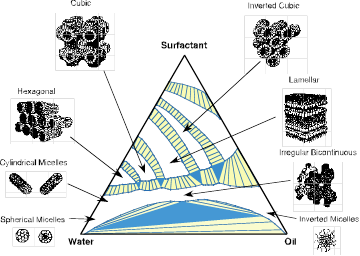
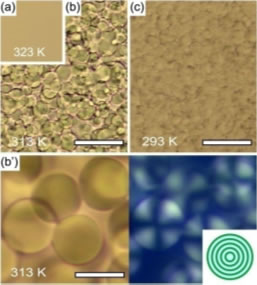
Onion-like structure generated by adding salt in water and an organic solvent (right).
Amoeba-like spontaneous motion of oil droplet
When an oil droplet with a fatty acid is dropped onto a surfactant aqueous solution, it spontaneously moves like an amoeba. At the interface between the water and the oil, gel-like aggregates are generated and blebbing motion of an interface has been observed. We investigated the nano-scale structure of this aggregates by means of Small-Angle X-ray Scattering (SAXS) and Small-Angle Neutron Scattering and found the ordered lamellar structure. From these kinds of research, we may approach the origin of the spontaneous motion of living systems.
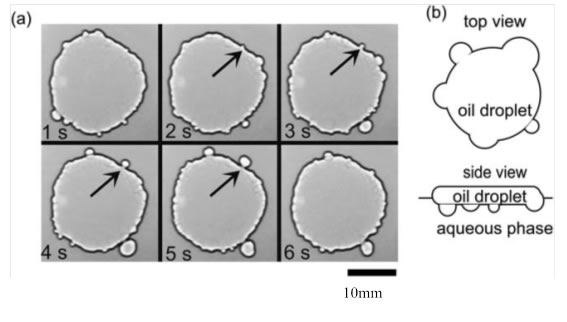
Spontaneous amoeba-like motion of an oil droplet.
Structure formation in a model bio-membrane
A "bio-membrane," which comprises cells and their organelles, consists of a phospholipid bilayer membrane (lipid bilayer) about 5 nm thick where biorelated materials such as proteins are embedded. This phospholipid, which is the basic material of biological membranes, is an amphiphilic molecule with hydrophilic part and hydrophobic part such as those seen in soap. When the phospholipid is dissolved in water, a bilayer membrane, such as a lipid bilayer, forms spontaneously. This phospholipid bilayer membrane is used not only for research in biochemistry as a biological membrane model, but also to study how a phospholipid bilayer membrane is self-assembled from the viewpoint of physics. Our group uses X-rays and neutrons to observe the nanoscale structures of model bio-membranes, and we control the structure by changing the temperature of phospholipid vesicles (soap bubbles in water made of phospholipids) and study deformation due to the addition of biorelated materials.
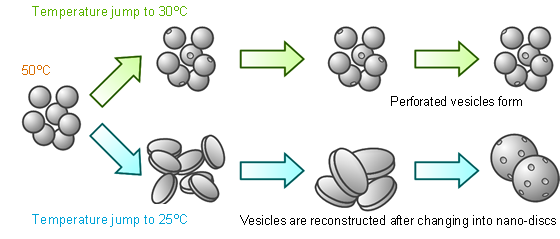 Example of structural control in phospholipid vesicles.
Example of structural control in phospholipid vesicles.
Crystal growth of cocoa butter
Cocoa butter in chocolate is like a capsule that confines the cocoa mass and sugar, which are related to the taste of chocolate. Although cocoa butter is almost tasteless, its physical properties are determined by the crystal structure of cocoa butter and it governs the food texture of chocolate. There are six types of the cocoa butter crystals, form I VI, in which how molecules are packed depends on the crystal type, as do its physical properties such as density and melting point. The form V crystal has a high density and its melting point is about 33ºC, which is most suitable for chocolate. It has an excellent snap when broken in room temperature and a smooth texture when it melts in the mouth. Research is ongoing to effectively produce the form V crystal by studying its structure in cocoa butter using neutrons.
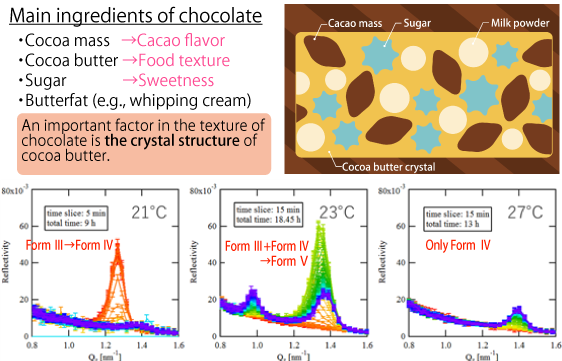 Schematic diagram of chocolate and an observational example of the crystal growth of cocoa butter.
Schematic diagram of chocolate and an observational example of the crystal growth of cocoa butter.
Study of friction and lubrication using neutrons and muons
Controlling "friction" at the interface of substances is very important to improve green products. "Lubrication" to reduce friction and wear is also important; however, there are many unknown factors in the basic principles of lubrication that need to be elucidated. We are conducting research on friction and lubrication, i.e., tribology, using neutron reflectometry, with which the interface between substances could be observed directly, and neutron quasielastic scattering and muon spin relaxation, with which dynamical behavior of molecules and molecular assemblies could be investigated.
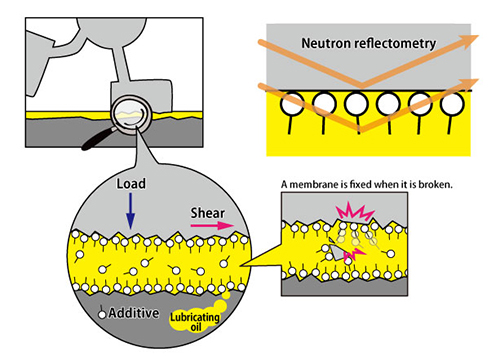 Study of friction and lubrication at an interface using a neutron reflectometer.
Study of friction and lubrication at an interface using a neutron reflectometer.
● Members
SETO, Hideki Professor Field: Soft Matter Physics
AOKI, Hiroyuki Professor (Cross Appointment/JAEA) Polymer Science
ENDO, Hitoshi Assoc.Professor Fields:Polymer Science, Biological Physics
YAMADA, Norifumi Assoc. Professor (CIQuS) Field: Soft Matter Physics
KIKUCHI, Tatsuya Assistant Professor
LIU, Yuwei Researcher
UZUKI, Shigeki Graduate students at SOKENDAI
RAHMAN, MD. Khalidur Graduate students at SOKENDAI
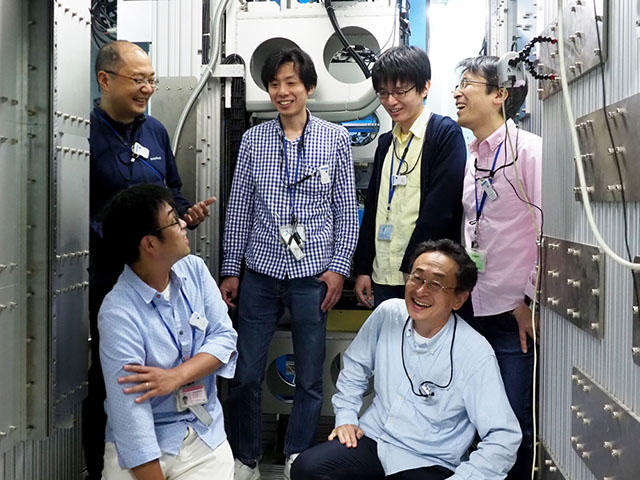
● Beamlines
Horizontal Type Neutron Reflectometer: SOFIA (BL-16)
Neutron Resonance Spin Echo Spectrometers: VIN-ROSE (BL-06)
